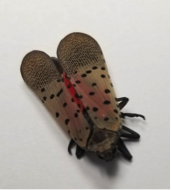A:
The spotted laternfly (SLF, Lycorma delicatula) is an invasive insect that has spread throughout southeastern Pennsylvania. It was first identified in Berks County, PA in 2014. This insect presents a significant threat to the agriculture industry. These pests typically attack fruit trees (but not the fruit itself). They feed on the sap in the tree leaving oozing wounds with grey or black trails on the bark. Even though it is not considered a structural pest, homeowners may see large populations of adults on or around their structure. So controlling spotted lanternfly may be require a multi-step approach.
Experts recommend the following steps for management of spotted lanternfly.
Controlling Spotted Lanternfly
- Stop the spread: When traveling in and out of quarantine zones, check car and other outdoor equipment for spotted lanternfly egg masses (late fall to early spring)
- Scrape lanternfly eggs: If spotted lanternfly egg mass is found from September to June, scrape them off using a plastic card or putty knife. Place egg masses in a container with isopropyl alcohol or hand sanitizer.
- Band trees: Trees can be wrapped with sticky tape/adhesive to capture nymphs. Be advised that non-target animals such as birds and small mammals may get stuck in adhesive.
- Remove tree-of-heaven: Tree of heaven (ailanthus altissima) is the preferred host plant of the SLF. Removal from the landscape may greatly reduce SLF populations in an area, thus mitigating lanternfly damage.
- Apply lanternfly insecticide: See active ingredient recommendations and management calendar below. (PennState Extension recommendations)
Insecticides for the spotted lanternfly
PennState Extension has put together the list below of active ingredients/insecticides recommended for spotted lanternfly control. *Note that some actives are systemic insecticide (absorbed by the host tree and then delivered to SLF when they feed on the plant directly) and other actives are contact insecticide (effective when pest comes in direct contact with the pesticide application area).
| Active Ingredient | Mode of Exposure |
| acetamiprid (neonicotinoid): Systemic/Contact |
| azadirachtin* (botanical): Contact |
| bifenthrin (pyrethroid): Contact |
| carbaryl (carbamate): Contact |
| dinotefuran (neonicotinoid): Systemic/Contact |
| imidacloprid (neonicotinoid): Systemic/Contact |
| thiamethoxam (neonicotinoid): Systemic/Contact |
| soaps*: Contact |
Chart taken from Penn State Extension: Spotted Lanternfly Management for Homeowners
Pest Management Professional Information: The spotted lanternfly is NOT considered a STRUCTURAL PEST. It can be treated as an occasional invader when found on or near the structure. Ornamental Applications require a category 6 or 7 license (depending on the site of application). Please refer to the Department of Agriculture’s Guidelines for the Control of Spotted Lanternfly.*Organic product
Note: This product list provides an example of insecticide products with these active ingredients. It is not an endorsement or specific recommendation.
Insecticides for Spotted Lanternfly
Spotted Lanternfly Permit Training for Businesses
Spotted lanternfly is an invasive insect that can damage many crops. Learn spotted lanternfly permit training and best practices to stop its spread. Businesses are required to complete this training to receive permits from the Pennsylvania Department of Agriculture (PDA).
What Do Spotted Lanternflies Look Like
Proper identification of lanterflies and their life stages (egg mass, nymph, adult) is also a key component for controlling spotted lanternfly. Check out this spotted lanternfly identification sheet for more information.


